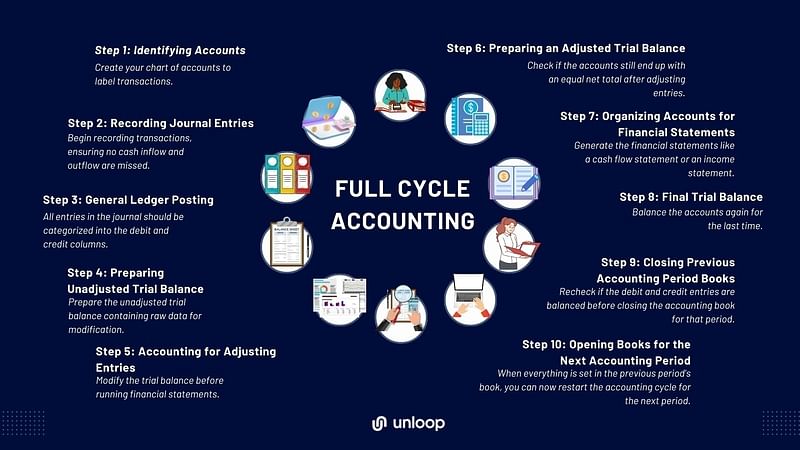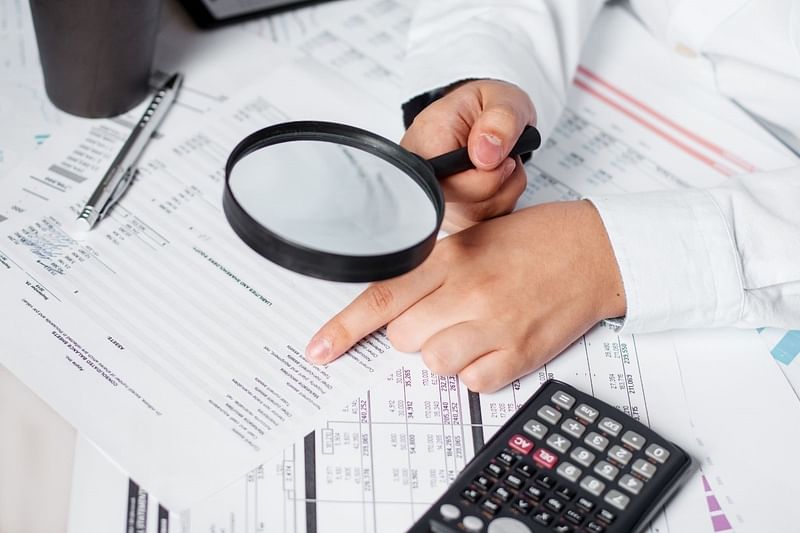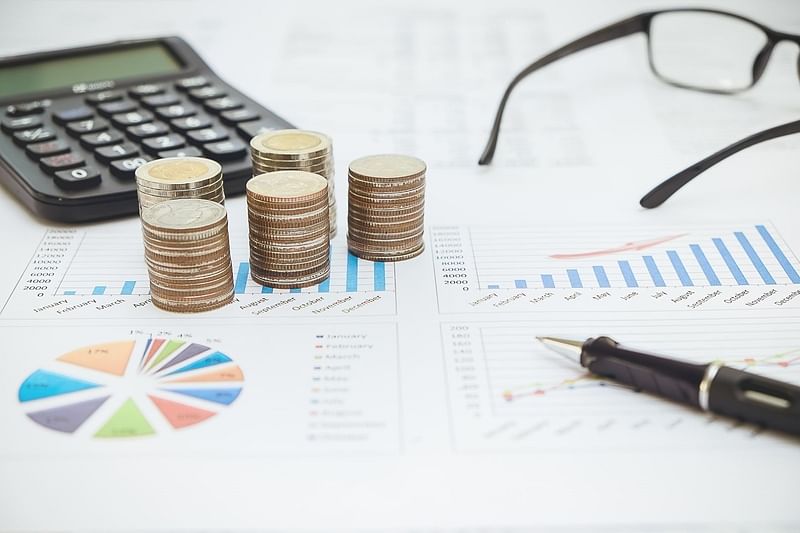
Disclaimer: Please note this article is not financial advice. The purpose of our blog is purely educational, so please consult a professional accountant or financial advisor before making any financial decision.
Full-cycle accounting is a vital aspect of managing finances for small businesses. It is the process of completing all accounting tasks needed in an accounting quarter—from recording financial transactions to preparing financial statements. It ensures accurate and up-to-date records, helps make informed business decisions, and ensures compliance with tax regulations.
This guide will help you determine your business reporting period and break down the steps of full cycle accounting and highlight the importance of financial management for small business owners.
Before setting up any bookkeeping or accounting system for your business, you must first determine your preferred accounting reporting period. The accounting period spans twelve months in which business transactions are recorded. You have two options when choosing an accounting period.
The calendar method is the default method used if you have no preferences. In this method, your accounting period follows the year's calendar in chronological order. That means you start recording on January 1 and then finish the recording period on December 31.
In this method, your accounting period is based on your preferred month. For example, If you choose your accounting period to start on April 1 of the current year, the ending period would be March 31 of next year. Big businesses and public accounting firms commonly use the fiscal year.
The chosen starting month can be arbitrary, or it can be based on multiple factors. For example, some choose their starting month strategically so that the ending month period would fall on a lean period. That way, they can focus more on the accounting part while the business is slow.
Accounting firms choose a fiscal period when the ending month falls on the tax-payment period, hitting two birds in one stone—create financial statements and pay appropriate taxes in one effort.
If you're not sure how your business behaves, it's okay to stick to the calendar period. Accounting periods can be changed in the future depending on your state's policy, so be sure to double check. Either way, you must choose wisely as accounting period changes may involve considerable paperwork.

After determining which accounting period you'll use, let's arm you with the knowledge of the full cycle accounting process, which includes recording and reporting transactions using financial statements.
Before you put any amount on paper, you'll need to identify your business's accounts first. These accounts are what the entire accounting cycle depends on.
In financial accounting, they are collectively known as the Chart of Accounts. Establish certain labels for transactions such as revenue, rent expenses, supplies expenses, utilities, and many more.
After all the accounts relevant to your business are set, you can start recording transactions. In your accounting journal, record every business-related activity with financial bearing, including receipts of payments you make for your business and payments your business receives from sales. Each entry is composed of at least two accounts, known as the double-entry method.
Your business should also have a general ledger for all the transactions and a sub-ledger to categorize them. For example, if you have a receipt acknowledging your payment to one of your suppliers, record that under the accounts payable ledger accounts. Depending on your business size, you can add different categories to your general ledger.
After all your business transactions are recorded in order, you have to validate them. First, see if all entries like assets, liabilities, cost of goods, sales, expenses, taxes, and other transactions are correct. Next, ensure both columns are balanced for credit and debit entries.
There are three types of journal entries to record in business transactions:
After recording transactions in the journal, you must post their respective amounts in the ledger account. Each account on the general ledger has a credit and a debit side where you can place the amount similar to where it is placed on the journal entry.
After an accounting period, you'll have to look at your general ledger again. Each account will have to be totaled. Get the sum of the ledger account debit and credit columns and then subtract them from each other. The difference will be the net amount of a particular account.
An unadjusted trial balance or entries are the transactions in your ledger by the end of the accounting period. These entries are untouched and are usually used by business managers and accountants to identify which ledgers need modifications to create financial statements.
After finding out the net total of all the ledger accounts, you'll have to line them all up again into the debit column and the credit column. The debit side net amount should be placed on the left column while the credit net amount should be on the right.
From there, you'll have to record the net total of all accounts. In the end, the sum of the debit column and the credit column must match each other. This is how you prepare the initial trial balance.
To generate the adjusted trial balance, you must modify journal entries as needed. This is the step where you or your accountants modify your ledgers to create financial reports.
The adjusted trial balance is the number that will appear on your financial statements, which you can use to create strategies, make business improvements, and pinpoint potential issues in your business.

After all the adjusting entries have been accounted for, you will create another trial balance to check if all the accounts and their net total post-adjustment will still be equal.
In most cases, businesses tend to have a lot of ongoing transactions during the accounting period. So it can be easy to lose track of the correct adjusting amounts. That's why an adjusted trial balance is necessary to ensure everything is balanced after the adjustment.
There are different financial statements you can produce for your business. These may differ depending on your business needs, but here are some of the common financial statements you will have to generate.
Balance Sheet
Balance sheets contain reports of the business's assets, liabilities, and stakeholders’ equity in a certain accounting period. These data points are used to evaluate the financial position of your business. Simply put, the balance sheet accounts for all that your business owns and owes, and the money invested by your stakeholders.
Cash Flow Statement
The cash flow statement shows the movement of cash in and out of your business. This financial statement shows how well you distribute your monetary resources, like how you generate cash and use it to fulfill your full cycle accounts payables. This financial report can also be the basis for some investors to know whether it's worth investing in your business.
Cash flow statements include cash flow from business activities like operations, financing, and investments. Furthermore, this data can be used by creditors to determine if they can give you credit and loans for your business.
Income Statement
Income statements are also known as profit and loss statements. This financial report shows your company's income and gains in a specific period. This statement shows all income and expenses whether from cash or credit receipts that there's no way to tell them apart.
Nevertheless, income statements are useful to know if your current operations are generating business income. It also helps determine which aspects of your business are underperforming, so you can make improvements.
If the adjusted trial balance yields an identical amount on the credit and debit side, you can prepare financial statements. You'll have to determine which of the accounts are nominal and real so you can place them in the proper column on the worksheet.
Before closing the books, you will ignore all the temporary like income statement accounts and collect the real accounts like the balance sheet again for a final trial balance.
In this phase, all your business revenue and expense accounts should be zeroed out in preparation for the next accounting period. This is necessary to verify if your credits and debits are balanced. These accounts will also be your starting point for the next accounting period, so transfer temporary account balances to permanent accounts.
All the financial transactions and their respective accounts on the previous books are reversed. Afterward, the books are closed. This leaves only the real accounts.
You will open new books, and the first journal entries are the real accounts from the pre-closing trial balance. Similarly, you will open a new general ledger, and the balance sheet accounts will have an opening amount.
Once all accounts are recorded in the proper places, the accounting cycle steps will restart and conclude in the next period.

An accounting cycle can also refer to other business activities besides income and expenses. Compared to a full cycle that usually lasts three months, these specific cycles can be shorter. Here are some of them.
The purchasing cycle is the process of acquiring goods for your business, from ordering to receiving. Full cycle accounts payable happens in this particular accounting cycle where your company makes a request or an order to purchase goods for your business.
Then, the supplier receives your order, you pay for it, and you acquire the goods.
The sales cycle is the full cycle accounts receivable of a business and it involves the following:
The payroll cycle involves every process between the employee and the business until the salary is received. The cycle starts with the employee submitting their time cards to human resources.
From there, the admin will make adjustments and approve them for payment. Then, the payroll is processed by computing the gross pay and all necessary deductions.
You don't need to feel like you're swimming in paperwork to optimize your business. You can successfully manage the accounting cycle and keep your business finances on track with these tips:
If you are a small business owner, doing all the tasks in the accounting cycle may be too much for you to handle. After all, accounting is not the only thing you do when running a business. If you need professional help, Unloop offers several accounting and bookkeeping services for busy business owners like you.
Here are some of the services we offer.
Unloop is your one-stop shop for bookkeeping and accounting solutions. Book a call with us today, and work with our experts!
Unloop is the first and only accounting firm exclusively servicing ecommerce and inventory businesses in the US and Canada. With the power of people and technology, our team dives deep into COGS and inventory accounting. You are paired with a dedicated bookkeeping team that prepares accurate financial statements, financial forecasts, and can also pay bills or run payroll for you. Come tax time, everything is organized and ready to go, so you don't need to worry. Book a call with an ecommerce accountant today to learn more.